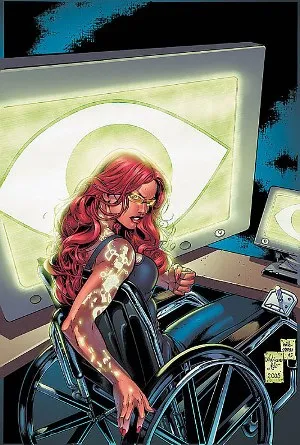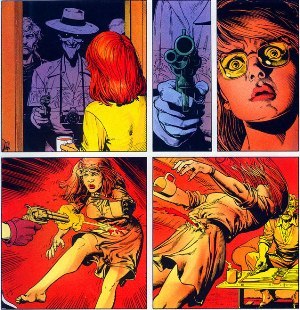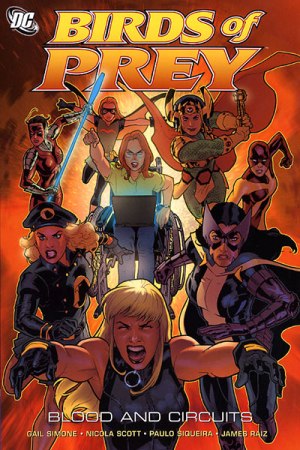We can probably all agree that what happened to Barbara Gordon in Alan Moore’s The Killing Joke was something of a low point for women in DC comics. In the 1988 comic, Barbara Gordon—the first Batgirl—was shot in the spine by the Joker and left with both her legs paralyzed. It wasn’t revenge for some spectacular feat of superheroism on Barbara’s part. Babs had just retired as Batgirl. No, the Joker went after Babs because hurting her would hurt her father, police commissioner and prominent Bat-ally Jim Gordon.
The editor had no plans for Barbara Gordon after her shooting. Except for her survival, it was a classic example of fridging—and not of a superhero’s girlfriend, but of a popular superheroine in her own right. So, you’d think I’d be happy when DC decided that for the New 52 reboot, Babs was getting surgery in South Africa and coming back as an able-bodied Batgirl.
I wasn’t.
There may not have been a plan for Barbara Gordon when The Killing Joke was written, but that doesn’t mean her story ended. Comic book writer and editor Kim Yale—writer of comics like Suicide Squad and Manhunter—had problems with the treatment of Batgirl in The Killing Joke, and with her husband, fellow comic book writer John Ostrander, she decided to do something about it. Instead of spinning Babs’ story back to before she was shot or offering a miracle cure, they started writing DC’s one and only superhero with a physical disability. And, despite the many times DC has claimed to increase representation of underrepresented groups in comics, there hasn’t been another like her. (Yes, DC has characters like Dr. Midnight, but his blindness is part of his super power—seeing in total darkness—not something that happens to real people.)
In 1988, a mysterious new character, whose face was never shown, going by the name of Oracle showed up in Yale and Ostrander’s Suicide Squad. All readers knew about the character was that she was an amazing hacker and total badass who’d started helping out everyone’s favorite band of not-quite-heroes. It wasn’t until 1990 and Suicide Squad issue 38 that Oracle was revealed to be none other than Barbara Gordon. Babs hadn’t been quietly retired; she was still fighting crime, only now using her genius intellect and skill with computers instead of her gymnastic skills. After this, various writers added her to their comics as the DCU’s premier information broker to the superheroes.
In 1996, we finally get Oracle’s superhero origin story from Yale and Ostrander in Oracle: Year One. In Year One, Babs says, “I was tired of being a victim. I had skills and abilities long before I became Batgirl. It’s time for me to make them work for me again.” Later in the comic, Babs has a dream where she finds a mysterious woman holding the mask that would come to be Oracle’s symbol. The woman tells her, “You’ve lost nothing that matters. You have everything you need.” Then Babs wakes up and decides to become a superhero again and fight the computer-themed supervillain Interface.
The idea that Babs still had everything she needed to be a superhero and a whole person after being paralyzed is a powerful one. In the world of superheroes, power often means physical power—the ability to leap tall buildings in a single bound or even just keep up with Batman as he runs across the rooftops of Gotham. Oracle demonstrated that being a superhero wasn’t about the body and that being in a wheelchair wasn’t an obstacle to being a superhero. (Though she continues to be a capable fighter.) In fact, in Year One, Babs thinks to herself that while Batgirl was an imitation of Batman, Oracle is the superhero identity that is completely hers.
1996 is also the year comics creator Chuck Dixon came out with the one shot comic Black Canary/Oracle: Birds of Prey. That team-up led to the Birds of Prey comic series written by Chuck Dixon and later by Gail Simone and others. In Birds of Prey, Oracle leads an all-female team of superheroes, many of whom have suffered at the hands of male characters, both heroes and villains. Babs uses her intelligence and computer skills not only to stop crime and take down bad guys, but also to help other women in the DCU get their sense of empowerment back.
She struggles with the loss of the gymnastic abilities that made her such an effective Batgirl, but lack of empowerment is definitely not Oracle’s problem. If anything, the main complaint her friends have about her is that she has a tendency to be too powerful. Being smarter than everyone else means that she can manipulate them, even if it is for what she considers to be their own good. Huntress actually leaves the Birds of Prey for a little while because she has a problem with how much power Oracle develops over her.
On top of that, Oracle is the best information broker in the DCU. Everyone in the Bat family, plus many of the other superheroes, are completely dependent on her for information. Villains are terrified she’ll find out about them. She has a whole team of powerful superheroes working for her. She also has a sassy best friend in Dinah Lance (Black Canary) and a brief relationship with Dick Grayson (Nightwing). In Birds of Prey, Babs develops into a smart, powerful, fully fleshed-out character who just so happens to have a disability.
With the New 52, we lose all of that. Babs is back to being Batgirl, and with that, she loses everything she built for herself. She’s given up her business as an information broker and her independence as a heroine unaffiliated with a leading male hero. She’s also given up the identity that she built for herself in trade for the one she built to impress Batman.
So, while the New 52 undid the damage of a hated moment in The Killing Joke, it also took away a powerful, independent woman and the only superhero with a physical disability in the DCU. I love Batgirl, but there have been lots of Batgirls. Cassandra Caine. Stephanie Brown. There’s only one Barbara Gordon and only one Oracle. In correcting its mistake with The Killing Joke, DC also took away the independence of one of its strong women and its one superhero with a physical disability.
Jessica Sirkin is a speculative fiction writer and technology journalist living in Boston with her pet rabbit, Lenore. Her short story, “The House in Winter” was a runner-up for the “Apex Magazine Best Story of the Year 2014” and was made into a podcast. She spends of her time sitting in front of a computer and should probably get out more. Follow her on twitter @jessicasirkin or find her onLinkedIn.
—Please make note of The Mary Sue’s general comment policy.—
Do you follow The Mary Sue on Twitter, Facebook, Tumblr, Pinterest, & Google +?










